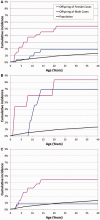Familial risk of epilepsy: a population-based study
- PMID: 24468822
- PMCID: PMC3927702
- DOI: 10.1093/brain/awt368
Familial risk of epilepsy: a population-based study
Abstract
Almost all previous studies of familial risk of epilepsy have had potentially serious methodological limitations. Our goal was to address these limitations and provide more rigorous estimates of familial risk in a population-based study. We used the unique resources of the Rochester Epidemiology Project to identify all 660 Rochester, Minnesota residents born in 1920 or later with incidence of epilepsy from 1935-94 (probands) and their 2439 first-degree relatives who resided in Olmsted County. We assessed incidence of epilepsy in relatives by comprehensive review of the relatives' medical records, and estimated age-specific cumulative incidence and standardized incidence ratios for epilepsy in relatives compared with the general population, according to proband and relative characteristics. Among relatives of all probands, cumulative incidence of epilepsy to age 40 was 4.7%, and risk was increased 3.3-fold (95% confidence interval 2.75-5.99) compared with population incidence. Risk was increased to the greatest extent in relatives of probands with idiopathic generalized epilepsies (standardized incidence ratio 6.0) and epilepsies associated with intellectual or motor disability presumed present from birth, which we denoted 'prenatal/developmental cause' (standardized incidence ratio 4.3). Among relatives of probands with epilepsy without identified cause (including epilepsies classified as 'idiopathic' or 'unknown cause'), risk was significantly increased for epilepsy of prenatal/developmental cause (standardized incidence ratio 4.1). Similarly, among relatives of probands with prenatal/developmental cause, risk was significantly increased for epilepsies without identified cause (standardized incidence ratio 3.8). In relatives of probands with generalized epilepsy, standardized incidence ratios were 8.3 (95% confidence interval 2.93-15.31) for generalized epilepsy and 2.5 (95% confidence interval 0.92-4.00) for focal epilepsy. In relatives of probands with focal epilepsy, standardized incidence ratios were 1.0 (95% confidence interval 0.00-2.19) for generalized epilepsy and 2.6 (95% confidence interval 1.19-4.26) for focal epilepsy. Epilepsy incidence was greater in offspring of female probands than in offspring of male probands, and this maternal effect was restricted to offspring of probands with focal epilepsy. The results suggest that risks for epilepsies of unknown and prenatal/developmental cause may be influenced by shared genetic mechanisms. They also suggest that some of the genetic influences on generalized and focal epilepsies are distinct. However, the similar increase in risk for focal epilepsy among relatives of probands with either generalized (2.5-fold) or focal epilepsy (2.6-fold) may reflect some coexisting shared genetic influences.
Keywords: epidemiology; epilepsy; familial aggregation; familial risk; genetics.
Figures


References
-
- Alstrom CH. A study of epilepsy in its clinical, social and genetic aspects. Acta Psychiatr Neurol Suppl. 1950;63:1–284. - PubMed
-
- Annegers JF, Hauser WA, Anderson VE, Kurland LT. The risks of seizure disorders among relatives of patients with childhood onset epilepsy. Neurology. 1982;32:174–9. - PubMed
-
- Annegers JF, Hauser WA, Elveback LR, Anderson VE, Kurland LT. Seizure disorders in offspring of parents with a history of seizures—a maternal-paternal difference? Epilepsia. 1976;17:1–9. - PubMed
-
- Annegers JF, Rocca WA, Hauser WA. Causes of epilepsy: contributions of the Rochester epidemiology project. Mayo Clin Proc. 1996;71:570–5. - PubMed
Publication types
MeSH terms
Grants and funding
LinkOut - more resources
Full Text Sources
Other Literature Sources
Medical

